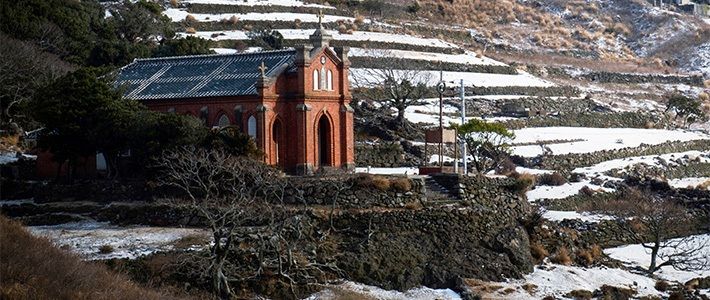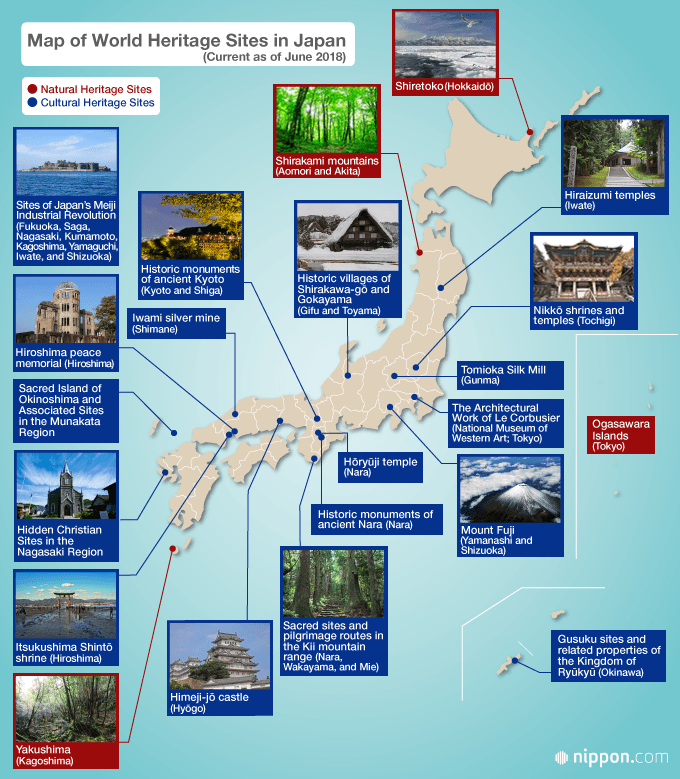
Christian Sites Selected for UNESCO List: An Overview of World Heritage Sites in Japan
Culture- English
- 日本語
- 简体字
- 繁體字
- Français
- Español
- العربية
- Русский
The Hidden Christians Who Secretly Practiced Their Faith
On June 30, 2018, the World Heritage Committee of UNESCO announced the official registration of the Hidden Christian Sites in the Nagasaki Region on its World Heritage list.
The locations include Ōura Church in Nagasaki; the remains of Hara Castle, where Christian farmers were besieged during the Shimabara Rebellion of 1637–38; and Sakitsu in Amakusa, a fishing village that was once a center for the faith. The UNESCO advisory body the International Council on Monuments and Sites commented that the sites bear testimony to the unique cultural tradition nurtured by Hidden Christians in the Nagasaki region who secretly practiced their faith despite a ban on Christianity.
Japan now has 22 World Heritage sites, including its four World Natural Heritage sites.
The Convention Concerning the Protection of the World Cultural and Natural Heritage (“the World Heritage Convention”), adopted at the 1972 General Conference of UNESCO, called for a list to be created of natural and cultural sites of “outstanding universal value.”
In December 1993, Japan’s first World Cultural Heritage sites were registered: the Buddhist Monuments in the Hōryūji Temple area (Nara Prefecture) and Himeji-jō Castle (Hyōgo). The seventeenth such site was registered in 2017, with the recognition of the Sacred Island of Okinoshima and Associated Sites in the Munakata Region. The country’s first two World Natural Heritage sites were also recognized in December 1993: Yakushima (Kagoshima) and Shirakami-Sanchi (Aomori and Akita). These were followed by Shiretoko (Hokkaidō) and the Ogasawara Islands (Tokyo), bringing the total number of sites to four.
As of June 2018, there are 1,073 World Heritage sites in the globe (832 World Cultural sites, 206 World Natural sites, and 35 mixed properties); a total of 193 countries have signed the “World Heritage Convention.”

| World Heritage Sites in Japan | Year listed |
|---|---|
| World Cultural Heritage Sites (Prefecture) | |
| Buddhist Monuments in the Hōryūji Temple Area (Nara) | December 1993 |
| Himeji-jō Castle (Hyōgo) | December 1993 |
| Historic Monuments of Ancient Kyoto (Kyoto and Shiga) ●Kiyomizudera Night & Day (360˚ Panorama) | December 1994 |
| The Historic Villages of Shirakawa-gō and Gokayama (Gifu and Toyama) ●World Heritage Site Shirakawa-gō: Snow-covered Roofs in a Traditional Mountain Village (360°/Gigapixel) | December 1995 |
| Hiroshima Peace Memorial (Hiroshima) ●World Heritage: Hiroshima Peace Memorial (Genbaku Dome) (360° Panorama) ●Hiroshima Peace Memorial Park: A Space to Remember the World’s First Atomic Bombing | December 1996 |
| Itsukushima Shintō Shrine (Hiroshima) ●World Heritage: Itsukushima Shrine (Time-Lapse Video) ●Miyajima: The Wonders of Japan’s Island Shrine (360˚ Panorama) | December 1996 |
| The Historic Monuments of Ancient Nara (Nara) ●Nara’s Kasuga Shrine: A Graceful Presence with a Millennium of History ●Ancient Messengers: The Timeless Deer of Nara (Photos) | December 1998 |
| The Shrines and Temples of Nikkō (Tochigi) ●Yōmeimon Gate Reopens to Public at Nikkō’s Tōshōgū Shrine | December 1999 |
| Gusuku Sites and Related Properties of the Kingdom of Ryūkyū (Okinawa) | December 2000 |
| Sacred Sites and Pilgrimage Routes in the Kii Mountain Range (Nara, Wakayama, and Mie) | July 2004 |
| Iwami Ginzan Silver Mine (Shimane) | June 2007 |
| Hiraizumi—Temples, Gardens, and Archaeological Sites (Iwate) ●World Heritage: Hiraizumi (Video) ●World Heritage in Hiraizumi: Iwate’s Chūsonji Embodies a Buddhist Realm ●World Heritage in Hiraizumi: Mōtsūji’s Pure Land Paradise ●World Heritage in Hiraizumi: Mount Kinkei and the Ruins of Kanjizaiōin and Muryōkōin | June 2011 |
| Fujisan—Sacred Place and Source of Artistic Inspiration (Yamanashi and Shizuoka) ●Mount Fuji Through the Lens of Ōyama Yukio (Photos) ●Mount Fuji: Where the Spirits Dwell (Photos) ●Japan’s Highest Shrine: Fujisan Hongū Sengen Taisha ●Mount Fuji in Edo Arts and Minds | June 2013 |
| Tomioka Silk Mill and Related Sites (Gunma) ●UNESCO Listing for Tomioka Silk Mill: Meiji-Era Structure a Symbol of Japan’s Modernization | June 2014 |
| Sites of Japan’s Meiji Industrial Revolution: Iron and Steel, Shipbuilding and Coal Mining (Fukuoka, Saga, Nagasaki, Kumamoto, Kagoshima, Yamaguchi, Iwate, and Shizuoka) ●Gunkanjima: A Sacred Site of Relics (360° Panorama) ●Takeaways from the World Heritage Listing for Sites of Japan’s Meiji Industrial Revolution | July 2015 |
| The Architectural Work of Le Corbusier, an Outstanding Contribution to the Modern Movement (National Museum of Western Art; Tokyo) ●Tokyo Art Museum Recognized in UNESCO List | July 2016 |
| Sacred Island of Okinoshima and Associated Sites in the Munakata Region (Fukuoka) ●Sacred Island Selected for UNESCO List ●Fukuoka’s Munakata Taisha: A Trio of Shrines and Their Precious Artifacts | July 2017 |
| Hidden Christian Sites in the Nagasaki Region(Nagasaki and Kumamoto) ●Exploring Nagasaki’s Gotō Islands and the History of the Hidden Christians ●The Natural Beauty and Historic Churches of the Gotō Islands (Video) ●Sakitsu: A Simple Fishing Village Becomes a World Heritage Site | June 2018 |
| Natural World Heritage Sites (Prefecture) | |
| Yakushima (Kagoshima) | December 1993 |
| Shirakami-Sanchi (Aomori and Akita) | December 1993 |
| Shiretoko (Hokkaidō) | July 2005 |
| Ogasawara Islands (Tokyo) | June 2011 |